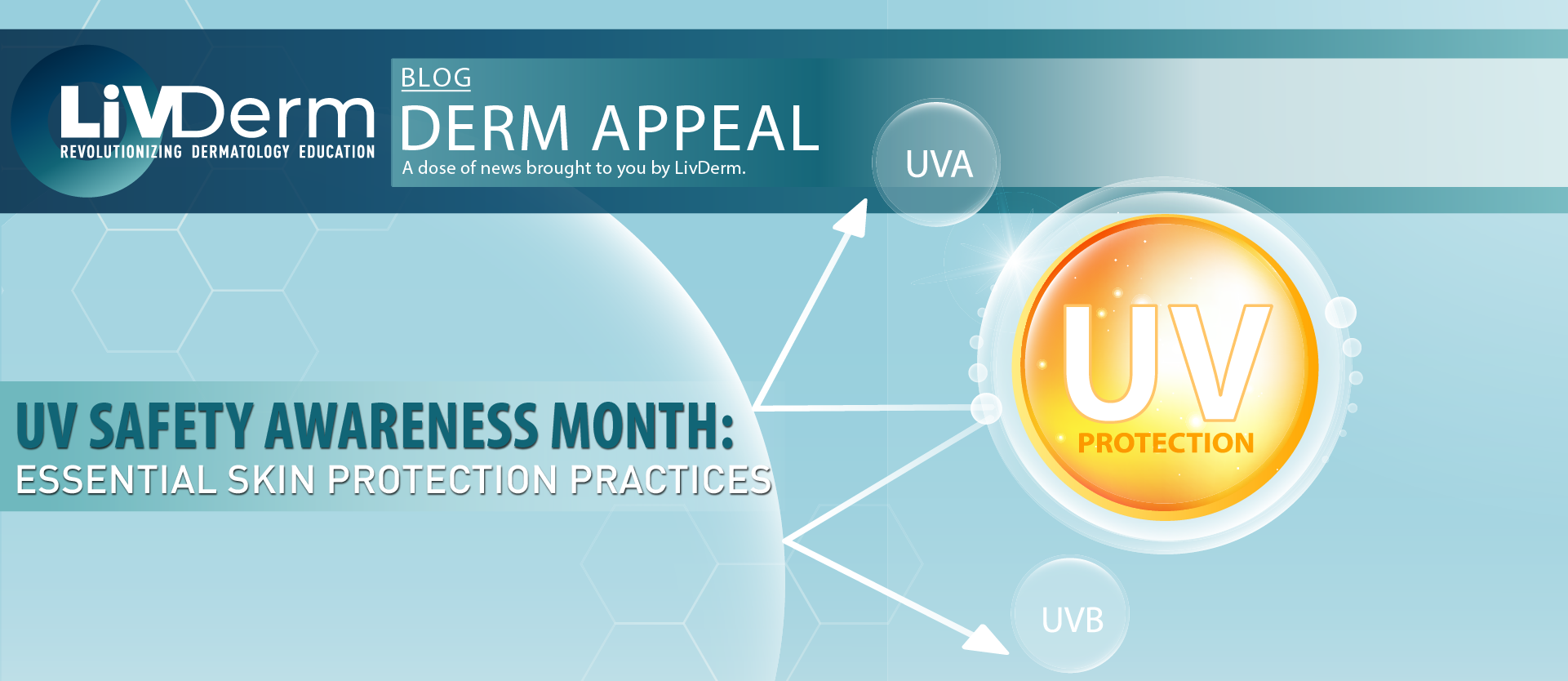The month of July is celebrated as UV Safety Awareness Month bringing attention to the many harmful effects of ultraviolet (UV) radiation exposure and underscoring the importance of sun-safe habits, skin protection, and other sun damage preventions strategies.
With over 5 million cases of skin cancer diagnosed per year in the United States alone, skin cancer is the most common of all cancer types. According to Mayo Clinic researchers, the number of cases of basal cell carcinoma (BCC) and squamous cell carcinoma (SCC) skin cancers has increased by 263% and 145% respectively in recent years. As one of the most preventable forms of cancer, melanoma is also the most common; about 90% of non-melanoma cancers and 85% of melanoma cases result from exposure to UV radiation.
UV Safety Strategies
The good news: skin cancer is one of the most preventable types of cancer and its incidence can be reduced with raised awareness and sun-safe habits. In both nonmelanoma and melanoma cancers, the majority is associated with sun and ultraviolet radiation exposure – both causes that can be easily mitigated. Protection from harmful UV rays is essential for skin cancer prevention and can be achieved with the following practices.
Apply Sunscreen Daily
Daily sunscreen application is the first essential step of a complete sun protection regimen. A generous application of a broad-spectrum, water-resistant sunscreen with an SPF of 30 or higher protects the skin from harmful sun rays. As UV radiation can filter through cloud coverage, it is essential to reapply sunscreen every two hours when outdoors and to cover all areas of exposed skin. Although, sunscreen alone is not enough to protect the skin from sun damage and the following additional safety measures should be incorporated to ensure optimal protection.
Avoid Sunbathing
Exposure to ultraviolet rays is harmful to skin cell DNA, damaging cells and leading to signs of aging and skin cancer. Seek shade as much as possible and avoid sunbathing for the best protection. Avoid the sun between the hours of 10 a.m. and 4 p.m. when ultraviolet radiation is at its peak and most harmful to the skin. Cover exposed facial skin with a wide-brimmed hat to further block UVA and UVB rays.
Abstain from Tanning Beds
Individuals are advised to refrain from using indoor tanning beds entirely, as the radiation levels can be even stronger than those from the sun and can cause severe skin cell mutations leading to cancerous lesions.
Wear Protective Clothing
Another essential component of an effective sun protection regimen is covering exposed skin by wearing protective clothing as it can significantly reduce skin cell damage associated with UV radiation exposure. Protective clothing now incorporates the ultraviolet protection factor (UPF) of 50 or more to protect the skin from UV ray exposure. It is also essential to protect the eyes; reducing the chances of ocular melanoma by 99% to 100% UVA and UVB absorption can be accomplished by wearing sunglasses, which also protect the skin around the eye area.
Importance of Regular Self-Examinations
Alongside the aforementioned preventative strategies, it is critical for individuals to self-examine their skin regularly as performing regular skin checks can help detect cancers at their early stages – when they are easiest to treat. With the COVID-19 outbreak reducing the number of non-emergency medical visits, including those routine skin exams conducted at dermatology clinics, many patients may not be able to undergo their routine preventative examinations. As many rely on these visits to assess their skin cancer risk, now is a critical moment to encourage patients to conduct regular self examinations and to take responsibility for their skin health.
Every one to two months, patients are encouraged to carefully conduct a skin exam beginning with the scalp, using a hand mirror to inspect the back of the body, and making sure all parts of the body are examined. They should be on the lookout for anything “new, changing, or unusual” during their self-examination. An easy way to remember what to look for during a skin self-exam is the ABCDE strategy outlined by the American Academy of Dermatology. This method includes evaluating markings on the skin for the following qualities: asymmetry, uneven or irregular borders, varying colors (black, brown, white, red, or blue), width larger than 6 millimeters in diameter, and any evolving features.
Patients are also encouraged to evaluate sores that have been present for over three weeks and are not healing as well as spots the continue to bleed, itch, or scab – all of which can be potential malignant growths. If any suspicious skin chances are discovered, patients are urged to consult their board-certified dermatologist immediately.
As the number of diagnosed skin cancer cases continues to rise, it is increasingly important to promote a well-rounded sun protection routine to limit the adverse effects of UV ray exposure. Incorporating the aforementioned preventive steps can help combat the skin cancer epidemic and prevent other sun-related diseases, while also ensuring early detection – which is critical to the efficacy of later treatment.
















